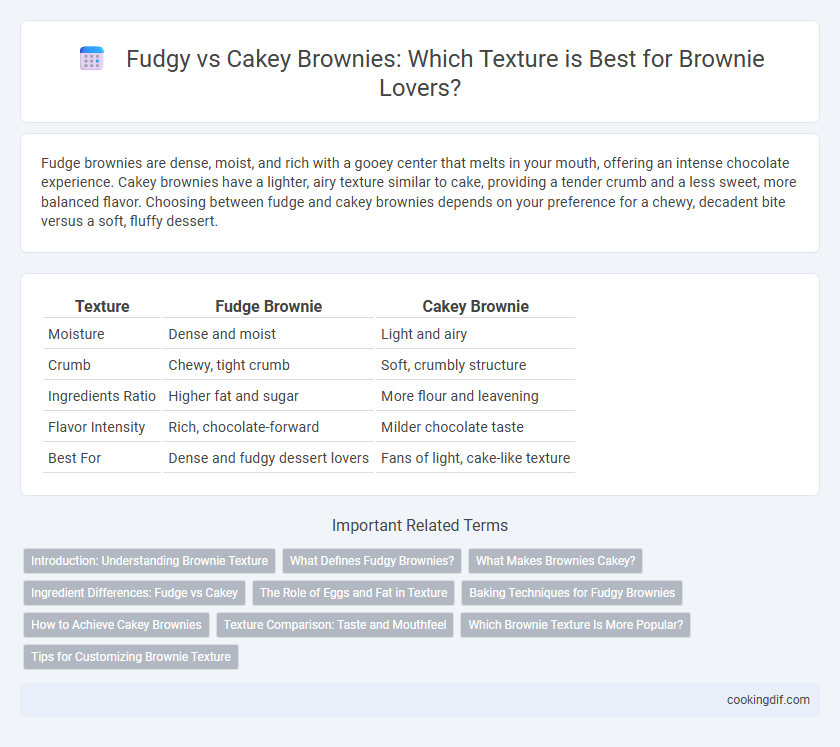Fudge brownies are dense, moist, and rich with a gooey center that melts in your mouth, offering an intense chocolate experience. Cakey brownies have a lighter, airy texture similar to cake, providing a tender crumb and a less sweet, more balanced flavor. Choosing between fudge and cakey brownies depends on your preference for a chewy, decadent bite versus a soft, fluffy dessert.
Table of Comparison
| Texture | Fudge Brownie | Cakey Brownie |
|---|---|---|
| Moisture | Dense and moist | Light and airy |
| Crumb | Chewy, tight crumb | Soft, crumbly structure |
| Ingredients Ratio | Higher fat and sugar | More flour and leavening |
| Flavor Intensity | Rich, chocolate-forward | Milder chocolate taste |
| Best For | Dense and fudgy dessert lovers | Fans of light, cake-like texture |
Introduction: Understanding Brownie Texture
Brownie texture varies primarily between fudge and cakey types, each defined by distinct ingredient ratios and baking methods. Fudge brownies contain higher fat and sugar content, producing a dense, moist interior with a glossy, crackly top. Cakey brownies incorporate more flour and leavening agents like baking powder, resulting in a lighter, airy crumb similar to traditional cake.
What Defines Fudgy Brownies?
Fudgy brownies are defined by their dense, moist interior with a rich chocolate flavor, achieved by using a higher fat-to-flour ratio and less leavening agent compared to cakey brownies. The texture is glossy and slightly gooey, often attributed to melted chocolate or butter combined with eggs and sugar, creating a chewy bite. Baking time is critical for fudgy brownies, as overbaking can dry them out, whereas precise timing preserves the signature soft, fudgy consistency.
What Makes Brownies Cakey?
Brownies become cakey primarily due to a higher ratio of flour and the inclusion of baking powder or baking soda, which introduces air pockets for a lighter texture. The use of eggs in greater quantity and slightly less fat, such as butter or oil, further contributes to a drier, crumbly consistency typical of cakey brownies. Proper mixing techniques that incorporate more air and avoid overmixing also enhance the cakey structure by promoting a tender crumb.
Ingredient Differences: Fudge vs Cakey
Fudge brownies contain a higher ratio of fat, such as butter or oil, and less flour, creating a dense, moist texture, while cakey brownies use more flour and baking powder or baking soda to introduce airiness and structure. The increased fat content in fudge brownies contributes to their rich, gooey consistency, whereas cakey brownies rely on leavening agents and eggs to achieve a light, airy crumb. Sugar content remains similar, but the balance of wet to dry ingredients significantly dictates whether the brownie turns out fudgy or cakey.
The Role of Eggs and Fat in Texture
Eggs provide structure and moisture while contributing to a chewy texture in fudge brownies, with their proteins coagulating during baking to create density. High fat content, typically from butter or oil, increases richness and softness, promoting a gooey, fudgy consistency. Adjusting the ratio of eggs to fat balances the moistness and firmness, defining whether a brownie leans cakey or fudgy in texture.
Baking Techniques for Fudgy Brownies
Fudgy brownies achieve their dense, moist texture by using a higher fat-to-flour ratio and incorporating melted chocolate or butter instead of cocoa powder. Precise temperature control and limited baking time prevent over-drying, ensuring a rich, gooey consistency. Folding in fewer eggs and avoiding excessive mixing minimizes gluten development, resulting in a tender, fudgy bite rather than a cakey crumb.
How to Achieve Cakey Brownies
To achieve cakey brownies, use a higher ratio of flour to fat compared to fudge brownies, incorporating baking powder or baking soda as leavening agents to create a lighter texture. Whipping the eggs and sugar together until fluffy introduces more air, contributing to the characteristic cakey crumb. Baking at a slightly lower temperature for a longer time ensures even cooking without drying out the brownies.
Texture Comparison: Taste and Mouthfeel
Fudge brownies are dense and moist, offering a rich, gooey texture that melts in the mouth, while cakey brownies have a lighter, airy crumb with a tender bite. The higher fat-to-flour ratio in fudge brownies creates a smooth, velvety mouthfeel, contrasting with the cakey variety's spongier, more structured texture. Taste-wise, fudge brownies deliver intense chocolate flavor with a chewy finish, whereas cakey brownies present a balanced sweetness and a slightly crisp exterior.
Which Brownie Texture Is More Popular?
Fudge brownies, characterized by their dense, moist, and rich chocolate flavor, tend to be more popular among chocolate enthusiasts seeking an indulgent treat. Cakey brownies offer a lighter, more airy texture reminiscent of chocolate cake, appealing to those who prefer a less dense dessert. Market surveys and consumer preference studies consistently show fudge brownies leading in popularity due to their intense flavor and chewy consistency.
Tips for Customizing Brownie Texture
For a fudgy brownie texture, use a higher fat-to-flour ratio by incorporating more butter or oil and reducing flour slightly, while minimizing leavening agents like baking powder to maintain density. To achieve cakey brownies, increase the flour and add baking powder or baking soda to introduce airiness, along with using eggs to provide structure and lift. Adjust baking time and temperature as well, baking fudgy brownies slightly shorter at a lower temperature and cakey brownies longer to develop a lighter, crumbly texture.
Fudge vs Cakey for brownie texture Infographic

 cookingdif.com
cookingdif.com